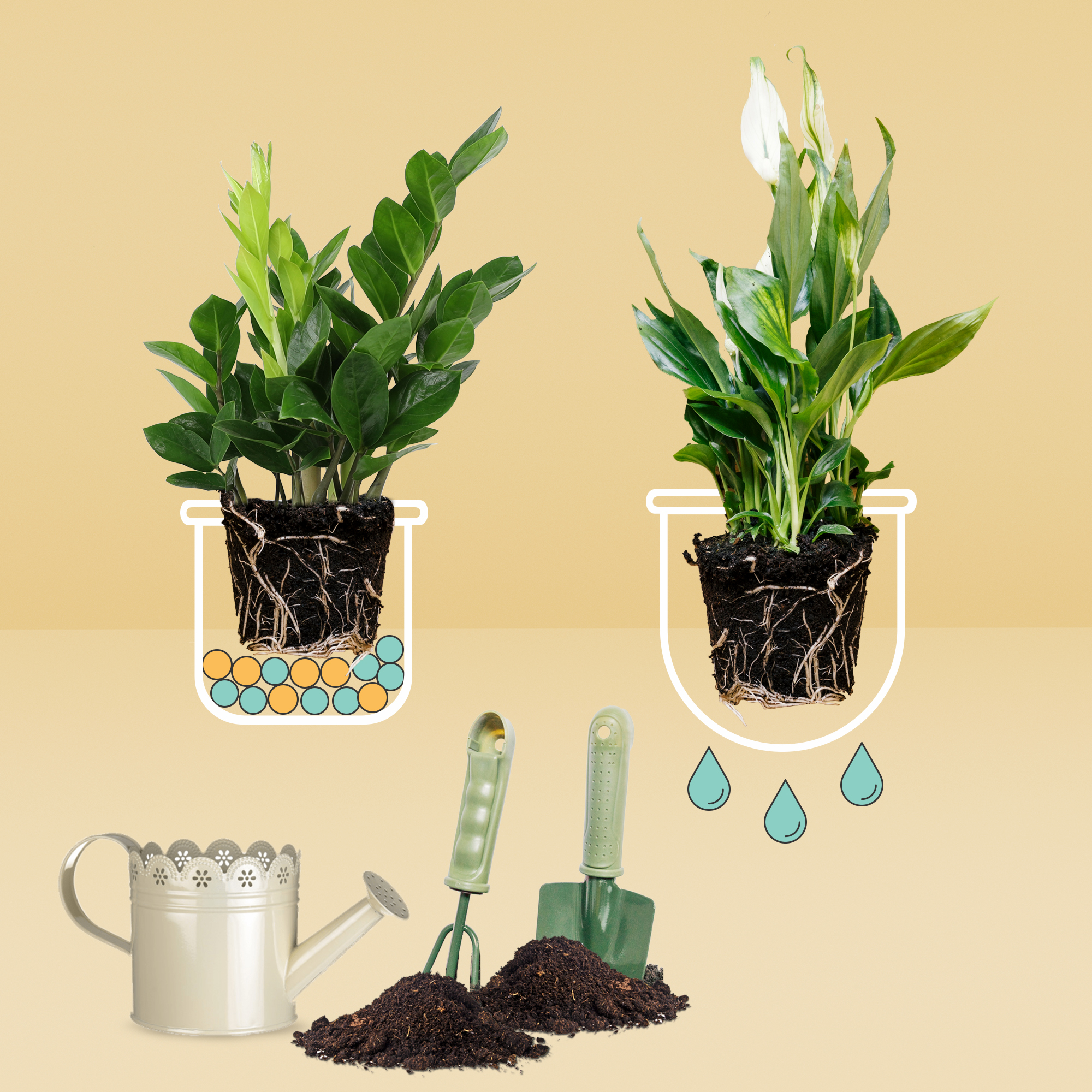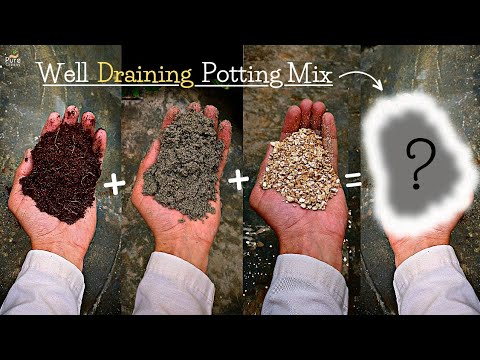To make potting soil drain better, add organic matter and vermiculite or perlite to improve aeration and drainage. This will help prevent waterlogged soil and promote healthy root growth.
Having well-draining potting soil is essential for the success of your potted plants. When soil becomes waterlogged, it can lead to root rot and hinder plant growth. By making a few simple adjustments to your potting mix, you can greatly improve its drainage properties.
This article will provide practical tips and techniques to help your potting soil drain better. By incorporating organic matter, such as compost or peat moss, and adding in materials like vermiculite or perlite, you can enhance both aeration and drainage. These adjustments will enable excess water to flow freely through the soil, preventing waterlogging and promoting optimal plant health. Read on to learn more about how to make potting soil drain better for your potted plants.

Credit: www.theleafyplant.com
Why Good Drainage Is Important For Potted Plants
Proper drainage is crucial for potted plants as it allows for adequate air circulation and prevents root rot and fungal diseases. When potting soil becomes waterlogged, oxygen cannot reach the plant’s roots, leading to suffocation and potential decay. To ensure good drainage, consider adding materials such as coarse sand, perlite, or vermiculite to the potting mix to improve its structure.
These amendments help create air pockets and allow excess water to freely drain away. Additionally, using pots or containers with drainage holes at the bottom helps remove any excess water that might accumulate. Regularly inspect your plants for signs of waterlogging and adjust watering frequency accordingly.
By providing proper drainage, you are creating a favorable environment that promotes healthy growth and prevents potential damage to your potted plants.
Factors Contributing To Poor Drainage In Potting Soil
Factors contributing to poor drainage in potting soil include soil composition and texture, container selection, and overwatering with lack of proper drainage holes. The composition and texture of the soil play a crucial role in its drainage quality. Some soils may have higher clay content, leading to poor drainage, while others with a sandy texture drain quickly.
Choosing the right container is also important. Containers without drainage holes can trap excess water, causing waterlogging and hampering drainage. Additionally, overwatering can exacerbate the problem by saturating the soil, leaving no room for proper drainage. To improve potting soil drainage, consider adding organic matter to improve soil texture, selecting containers with drainage holes, and practicing proper watering techniques.
How to Make Potting Soil Drain Better
Choosing The Right Ingredients For Well-Draining Potting Soil
Choosing the right ingredients is crucial to ensure well-draining potting soil. Incorporating organic matter like compost or peat moss helps improve drainage. Additionally, using coarse materials such as perlite or vermiculite helps create air pockets that allow excess water to flow through.
These materials also prevent the soil from becoming compacted, ensuring optimal drainage. The proper balance of organic matter and coarse materials helps create a healthy and well-draining potting soil. With these tips, you can ensure that your plants thrive in pots or containers without the risk of waterlogging.
So, next time you prepare potting soil, remember to choose the right ingredients to promote better drainage.
Adjusting Soil Composition To Enhance Drainage
To make potting soil drain better, it is crucial to adjust the composition of the soil. This involves balancing the ratio of organic matter to inorganic materials. By doing so, you can prevent the soil from becoming heavy clay, which tends to hinder drainage.
To enhance drainage, opt for a mix that includes a good amount of organic matter, such as compost or peat moss. This will improve the soil’s ability to retain moisture while still allowing excess water to drain away. Additionally, incorporating inorganic materials like perlite or vermiculite can further enhance drainage by creating air pockets in the soil.
This combination of organic and inorganic materials in the right proportions will ensure optimal drainage, creating an ideal environment for healthy plant growth.
Enhancing Drainage With Appropriate Container Selection
Enhancing the drainage of potting soil can be achieved by selecting containers with drainage holes. In addition, you can use pot feet or risers to elevate the container. Elevating the container helps in preventing waterlogging and allows excess water to flow out easily.
By ensuring proper drainage, you can avoid issues like root rot and stagnant water, which can be detrimental to plant health. So, when choosing containers for your potting soil, opt for ones with adequate drainage holes and consider using pot feet or risers to further enhance drainage.
This will create an environment where your plants can thrive and grow to their full potential.
Creating A Drainage Layer At The Bottom Of The Container

To improve drainage in potting soil, create a layer at the container’s bottom. Adding rocks or gravel helps enhance water flow, preventing over-saturation of plants’ roots. This improves aeration and prevents waterlogged soil, which can lead to root rot. By allowing excess water to drain effectively, the risk of water accumulating and causing damage to plant roots is minimized.
The rocks or gravel create air pockets between the particles, facilitating oxygen exchange for healthier root growth. This drainage layer should be about one to two inches thick, depending on the container’s size. It is important to note that this technique is not suitable for all plants, as some species require more moisture-retentive soil.
Consider the specific needs of your plants before incorporating a drainage layer into your potting soil mix.
Amending Potting Soil With Various Additives
To improve the drainage of potting soil, you can add sand or grit to the mix. This will enhance water flow and prevent waterlogging. Another option is to incorporate wood chips or bark, which will improve aeration within the soil.
These additives will create air pockets, helping the roots to access oxygen more easily. By amending the potting soil in this way, you can ensure that excess water drains quickly, preventing the risk of root rot and promoting healthy plant growth.
So, consider mixing in sand or grit for better drainage and adding wood chips or bark for improved aeration when preparing your potting soil.
Implementing Proper Watering Practices
Implement proper watering practices to make your potting soil drain better. Allow the soil to dry between waterings, preventing waterlogging. Apply water in small amounts to avoid overwatering and ensure proper drainage. By following these guidelines, you can create an optimal environment for your plants to thrive.
Proper watering techniques provide the right balance between moisture and air in the soil, allowing roots to access water while avoiding saturation. This prevents the soil from becoming compacted and ensures nutrients are readily available to your plants. Remember to observe your plants’ needs and adjust your watering schedule accordingly.
With the right approach, you can improve the drainage of your potting soil and create a healthier growing environment for your plants.
Frequently Asked Questions For How To Make Potting Soil Drain Better
How Can I Improve The Drainage Of My Potting Soil?
To improve drainage, add organic matter like compost, perlite, or vermiculite to your potting soil. These additives help to loosen compacted soil and increase its ability to drain excess water. Make sure to choose a well-draining potting mix and avoid overwatering your plants.

What Are The Common Causes Of Poor Soil Drainage?
Poor soil drainage can be caused by various factors such as heavy clay soil, compacted soil, inadequate soil amendments, or improper potting mix. These conditions can lead to waterlogged soil, root rot, and poor plant growth. It is essential to address these issues to ensure proper drainage and plant health.
How Often Should I Water Plants With Well-Draining Potting Soil?
Plants with well-draining potting soil should be watered when the top inch of soil feels dry. Avoid overwatering as it can lead to waterlogged soil and root rot. The frequency of watering depends on various factors such as plant type, environmental conditions, and season, so it’s best to monitor the soil moisture level regularly.
Conclusion
Improving the drainage of potting soil is crucial for healthy plant growth. By following the tips and techniques discussed in this blog post, you can ensure that your plants receive the right amount of moisture and oxygen. Start by incorporating organic matter such as compost or peat moss into the soil to enhance its structure.
Amend the soil with perlite or vermiculite to increase drainage and prevent compaction. It’s also important to choose the right container size and shape to promote proper drainage. Lastly, regular monitoring of soil moisture levels and adjusting watering practices accordingly will help maintain optimal drainage conditions.
By taking these steps, you can effectively improve the drainage of your potting soil and provide a thriving environment for your plants to grow. Happy gardening!

